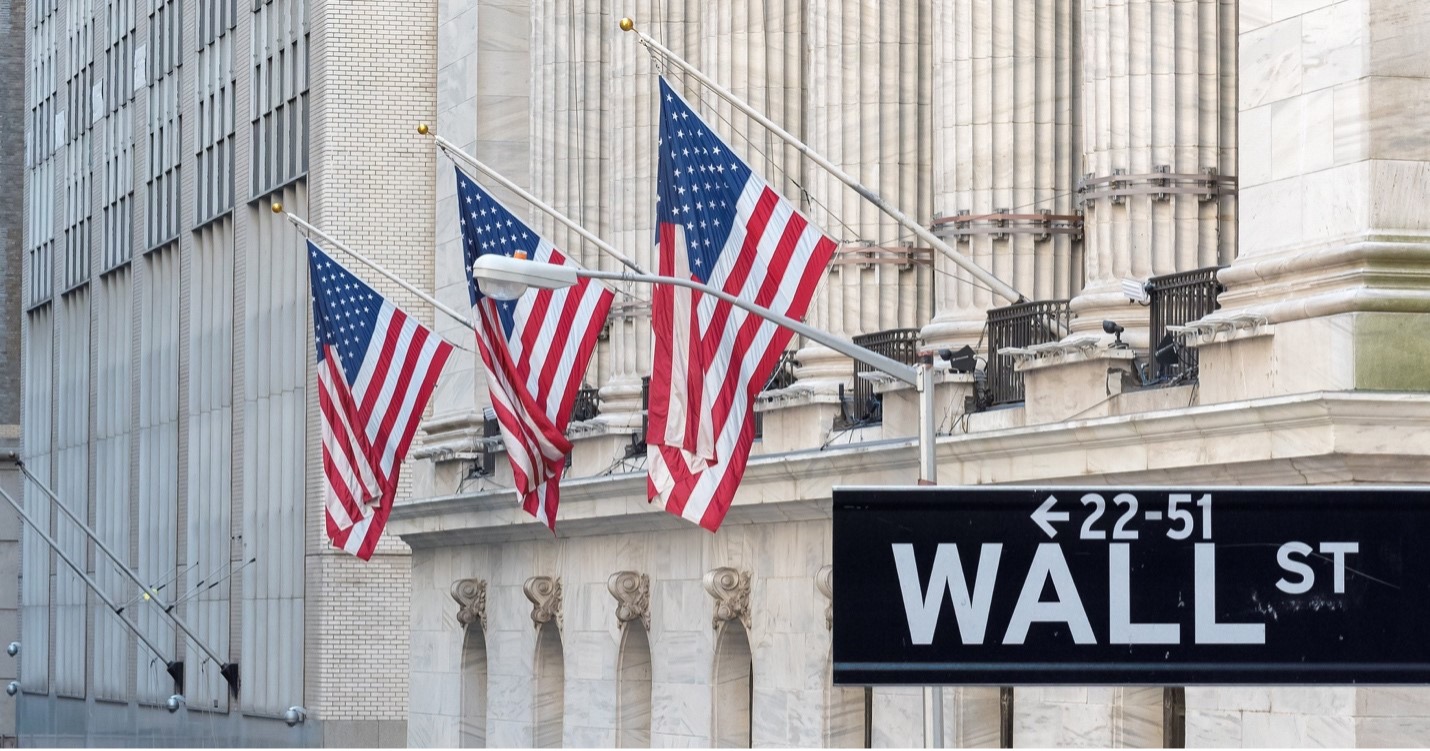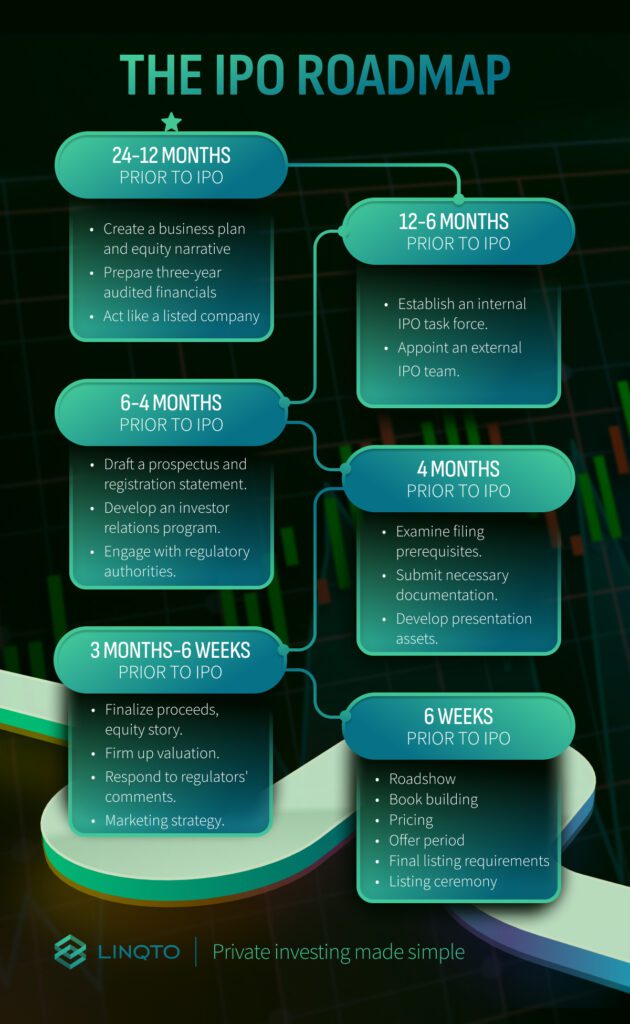By Ryan Prete, Jun 27, 2023

Every year, scores of companies list their shares on the public markets in hopes of raising capital, offering up pieces of their businesses to accredited and retail investors. Holding an IPO is a lengthy and time-consuming decision; it’s also an exclusive club, as not every business that wishes to go public gets their wish granted. In fact, there have been only around 6,000 IPOs since 2000. In this piece, we’ll explore the steps behind an IPO, what it takes, what alternative paths there are to a traditional IPO, pre-IPO investing, and more.
Table of Contents
Initial Public Offerings (IPOs), are key milestones in a company’s journey, transforming it from a private firm to a public entity. This strategic step allows the organization to access capital from public markets by selling shares for the first time. Initiating a IPO involves partnering with investment banks to guide the process, setting the price for the shares, and organizing promotional roadshows to attract interest from large institutional investors. The transition not only opens new avenues to funding but also enhances the company’s visibility and validates its business model for potential growth.
The funds generated from an IPO can be deployed for various objectives such as expanding the business, paying off debt, investing in research and development, or facilitating acquisitions. Additionally, an IPO provides liquidity for the company’s existing shareholders, including employees and early investors, acknowledging their early support and investment.
The IPO process is a complex one, and the time length depends on many factors. If the team managing the IPO is well organized and efficient, then the total process can be expended to take six to nine months for a company to complete its public debut.
When a company decides to go public, it normally follows a selection process to choose an underwriter—synonymous with an investment bank—that will underwrite the offering; assisting in the IPO process. This selection is a crucial and critical decision which can make or break the success of the IPO. During the selection process, companies will look at an investment bank’s reputation, spending great amounts of time on due diligence. Once an underwriter is picked, the company and the underwriter formally agree on terms, known as an underwriting agreement. This agreement also includes the amount of money the underwriter receives for its services, which typically ranges from five to eight percent of the IPO proceeds.
Due diligence is a very standard process, used for any investment, and always for IPOs. In the IPO process, due diligence refers to a rigorous and comprehensive investigation conducted by a number of parties involved in the IPO of a company, including its legal team, financial advisors, underwriters, and regulators. The purpose of due diligence is to verify the accurarcy and reliability of information about the company and its financials, operations, and other necessary information disclosed in its IPO documents.

The IPO process involves the preparation and filing of a number of various documents, submitted to regulatory authorities and stock exchanges. The exact documents needed can depend based on the location of the company and other various requirements. Here are the common documents typically prepared and filed:
The contract between the company and the underwriters—the investment bank—which outlines the terms and conditions listed above.
This document, filed by the underwriter, is a preliminary prospectus containing information on the company’s operations, but doesn’t include share price, number or shares, or other similar information.
These refer to various legal and financial disclosures including management discussions and analysis, risk factors, audited financial statements, legal proceedings, material contracts, and more.
These documents refer to a company’s bylaws, articles of incorporation, board committee charters, code of ethics, and more.
Interested in investing in Artificial Intelligence (AI)?
This filing refers to which stock exchange, if applicable, a company intends to list its shares on, such as the Nasdaq, NYSE, and others. This application may include information about a company’s corporate structure, financial information, compliance requirements, and other information.
These documents refer to filings consisting of investor presentations, roadshow materials, marketing campaigns, press releases, and other material that will generate and grow awareness about the IPO to a pool of potential investors.
The most widely-know and referenced IPO filing, this comprehensive document is the primary document filed to the Securities and Exchange Commission, therefore initiating the IPO process. It contains droves of detailed information, including the company’s business model and purpose, its financials, risks, management structure, and much more information required by the SEC.
IPO pricing is determined and set through a lengthy process which involves the company, its underwriters, and the consideration of investor demand and of current market conditions. A price is determined once the parties agree to a number that can generate a targeted proceed goal while also being attractive to potential investors. When it comes to determining a company’s valuation, a handful of relative valuation methods are used to value a company, including:
A valuation method that examines the value of an investment based on its projected future cash flows.
A valuation method that compares and contrasts companies that are already publicly traded and which exist in a similar sector and location—and also with comparable revenue and market capitalization—to the company involved in the IPO process.
Ready to Invest? Discover Investment Options Today.
a valuation method which examines historical prices or completed deals within the private markets, which also involve similar companies that are already public.
Over the past decade, a growing number of companies have chosen to forgo the IPO route, instead opting for alternative methods to listing on the public market.
Direct Listing (Direct Public Offering – DPO) allows a company to go public without issuing new shares or raising capital through the traditional IPO process. Instead, existing shareholders can sell their shares directly to the public on a stock exchange. This method eliminates the need for IPO underwriters, potentially saving the company significant amounts in fees and offering a more streamlined path to going public.
Direct listings have been particularly appealing to smaller, budget-conscious businesses seeking to avoid the large expenses associated with a traditional IPO. This approach might not attract the same extensive pool of investors that a traditional IPO does, due to the absence of underwriters who also help market the new shares.
Special Purpose Acquisition Companies (SPACs) offer a streamlined pathway for private companies to go public, bypassing the traditional IPO process by merging with a publicly traded shell company, also known as a “blank check company”.
The SPAC process has come under more scrutiny from regulators recently to ensure the protection of investors. Historically, they had less oversight and have run into disclosure issues.
Investing in a company pre-IPO can come with some advantages. There are a limited number of platforms that allow accredited investors to invest in a company pre-IPO—Linqto is of course one of them. Some advantages include: Potential for higher returns, opportunity to participate in a company’s early growth stages, the potential to access shares at a lower valuation, access to new and promising sectors, ability to invest in companies that promise to disrupt or innovate old-school industries, and the ability to diversify an investors portfolio.
Some risks of investing pre-IPO include: limited information and limited-access to financial disclosures to the investor, higher risk and uncertainty of investments, Illiquidity and lock-up periods for investors—meaning that investors may have to hold onto to pre-IPO shares for longer periods of time before being able to sell them—constant valuation changes of a pre-IPO company, and more.
At Linqto, we seek to educate accredited investors on market topics of all variations. Read more about our latest series on IPOs by clicking here.
This material, provided by Linqto, is for informational purposes only and is not intended as investment advice or any form of professional guidance. Before making any investment decision, especially in the dynamic field of private markets, it is recommended that you seek advice from professional advisors. The information contained herein does not imply endorsement of any third parties or investment opportunities mentioned. Our market views and investment insights are subject to change and may not always reflect the most current developments. No assumption should be made regarding the profitability of any securities, sectors, or markets discussed. Past performance is not indicative of future results, and investing in private markets involves unique risks, including the potential for loss. Historical and hypothetical performance figures are provided to illustrate possible market behaviors and should not be relied upon as predictions of future performance.
Can a Company IPO Twice?
Yes, it is possible for a company to conduct multiple IPOs and go public more than once. This is known as a secondary IPO or a follow-up offering. A secondary IPO occurs when a company that is already publicly traded decides to offer additional shares to the public.
There are several reasons why a company may choose to conduct a secondary IPO:
1. Capital Raise: The company may seek to raise additional capital to fund its growth initiatives, acquisitions, research and development, or other expansion plans. By issuing more shares to the public, the company can generate funds that can be used for various purposes.
2. Existing Shareholders’ Exit: In some cases, existing shareholders, such as early investors, founders, or employees, may want to sell their shares to realize their investments or monetize their equity holdings. A secondary IPO allows these shareholders to sell their shares on the public market.
3. Enhancing Liquidity: By conducting a secondary IPO, a company can increase the liquidity of its stock. The increased trading volume and broader investor base can lead to improved liquidity, making it easier for shareholders to buy or sell shares.
4. Increasing Public Awareness: A secondary IPO can raise the company’s profile and increase public awareness. It provides an opportunity for the company to gain additional exposure, attract new investors, and enhance its visibility in the market.
What Happens When a Public Company is Taken Private?
When a public company is taken private, it means that the company’s shares, previously traded on a public stock exchange, are no longer available for trading by the general public. Instead, the company’s ownership is transferred to a group of private investors or a single private entity. This process is often referred to as a privatization or going private.
Here’s an overview of what typically happens when a public company is taken private:
1. Acquisition proposal: A group of investors, which can include management, private equity firms, or other entities, makes a proposal to acquire all outstanding shares of the public company. This proposal is presented to the company’s board of directors.
2. Negotiation and Due Diligence: If the board of directors deems the acquisition proposal favorable, negotiations begin between the acquiring group and the company’s board or a special committee representing shareholders. During this stage, due diligence is conducted to assess the company’s financials, operations, and legal matters.
3. Shareholder Approval: Once the terms of the acquisition are agreed upon, the proposed transaction is presented to the company’s shareholders for approval. The shareholders vote on whether to accept the offer. Typically, a majority of shareholders must approve the privatization for it to proceed.
4. Financing and Transaction Closure: The acquiring group secures the necessary financing to complete the transaction. This can involve obtaining debt financing, equity contributions from the investors, or a combination of both. Once the financing is in place, the privatization is executed, and the public company becomes privately held.
5. Delisting and Ownership Transfer: After the privatization is finalized, the company’s shares are delisted from the public stock exchange, and trading in those shares ceases. The ownership of the company is transferred to the acquiring group, and the company’s shares are no longer available for public trading.